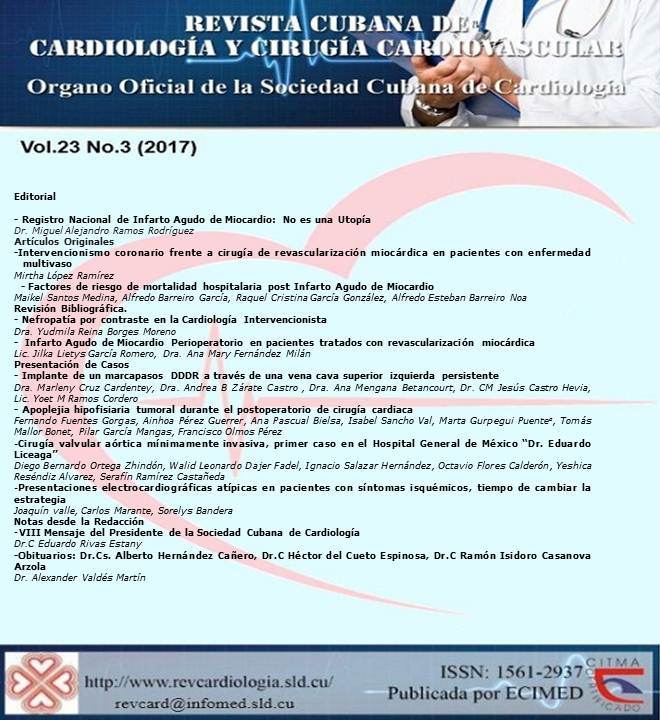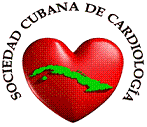Risk factors of hospitality mortality in patients after acute myocardial infarction.
Keywords:
Acute myocardial infarction, mortality, risk factorsAbstract
Introduction: Several factors have been associated with a bad prognosis and high hospital mortality in acute myocardial infarction.Objectives: To determine the risk factors for hospital death due to myocardial infarction at the Cardiology Service of the Ernesto Guevara´s Hospital of Las Tunas.
Methods: An analytical study was performed in patients with acute myocardial infarction. The 55 patients who died of myocardial infarction constituted the study sample, "CASES GROUP". For each deceased patient, 3 patients with randomly selected live infarct were selected, "CONTROL GROUP". Descriptive statistics were used through the percentage analysis for the descriptive variables. For age, blood glucose, creatinine and blood pressure at admission, the standard deviation arithmetic mean was used. For the determination of hospital mortality risk factors, a multiple logistic regression model was used, using as the dependent variable the state at discharge (deceased or alive). Odds ratio (OR) and confidence intervals were calculated for 95% confidence. A value of p <0.05 was considered statistically significant.
Results: The average age of the deceased was 74 + 11 years, 87.3% were hypertensive, 70.9% came late to the first medical care. The blood glucose indexes at admission were high (15.5 + 11 mmol / L). 73.5% of the deceased presented non-effective thrombolysis or did not thrombolize. KK IV was present in 67.3% of the deceased. Reinfarction (OR 12,669), diabetes mellitus (OR 7.706), arterial hypertension (OR 4,610) and elevated creatinine (OR 4,967) behaved as risk factors for hospital mortality.
Conclusions: Reinfarction, diabetes mellitus, high blood pressure and elevated creatinine levels behaved as risk factors for hospital mortality.
Downloads
Published
How to Cite
Issue
Section
License
Aquellos autores/as que tengan publicaciones con esta revista, aceptan los términos siguientes:- Los autores/as conservarán sus derechos de autor y garantizarán a la revista el derecho de primera publicación de su obra, el cuál estará simultáneamente sujeto a la Attribution-NonCommercial 4.0 Internacional (CC BY-NC 4.0) que permite a terceros compartir la obra siempre que se indique su autor y su primera publicación esta revista. o admite fines comerciales. Permite copiar, distribuir e incluir el artículo en un trabajo colectivo (por ejemplo, una antología), siempre y cuando no exista una finalidad comercial, no se altere ni modifique el artículo y se cite apropiadamente el trabajo original. El Comité Editorial se reserva el derecho de introducir modificaciones de estilo y/o acotar los textos que lo precisen, comprometiéndose a respectar el contenido original.
- Los autores/as podrán adoptar otros acuerdos de licencia no exclusiva de distribución de la versión de la obra publicada (p. ej.: depositarla en un archivo telemático institucional o publicarla en un volumen monográfico) siempre que se indique la publicación inicial en esta revista.
- Se permite y recomienda a los autores/as difundir su obra a través de Internet (p. ej.: en archivos telemáticos institucionales o en su página web) antes y durante el proceso de envío, lo cual puede producir intercambios interesantes y aumentar las citas de la obra publicada. (Véase El efecto del acceso abierto).









